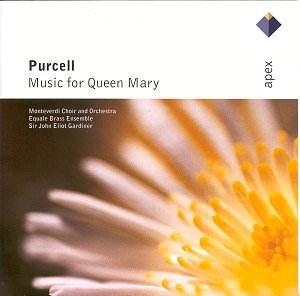Purcell composed a celebratory work for
each of the birthdays of Queen Mary’s six-year reign, but Come
ye Sons of Art (1694) is the richest and most festive of
them all. Even greater is the magnificent and poignant Music
for the funeral of Queen Mary (1695), a work that confers
an added sense of retrospective melancholia when we consider that it
was also played at Purcell’s own funeral in Westminster Abbey a few
months later.
This recording is nothing short of a
revelation, and a jewel among John Eliot Gardiner’s early music recordings.
The only significant problem I have with the disc is that the voices
(and soloists in particular) are not quite forward enough in the mix.
The instruments take precedence throughout both works, and, occasionally
I would have preferred greater projection of the vocals, particularly
bass Thomas Allen. However, with singing and playing of this order such
misgivings are easily overcome.
Come ye Sons of Art opens with a beautifully
poised overture, in which the strings and trumpets interplay to evoke
an atmosphere of anticipation. A joyful movement arranged for solo countertenor
follows, where the invitation to “celebrate this triumphant day” is
echoed by a full chorus accompanied by trumpets. This combination plays
to Gardiner’s strengths, and the celebratory atmosphere is superbly
evoked even though the choir is restrained throughout.
Of the other movements, the interplay
of flute and rich strings in Strike the viol, is particularly beautiful.
Thomas Allen, despite the recording-related issue already mentioned,
is tremendous in The day that such
a blessing gave. Felicity Lott sings the most delicate aria,
Bid the virtues quite beautifully, accompanied
by a lightly played oboe obbligato (alas, the instrumentalists are not
identified on this budget reissue). Allen and Lott come together in
the final movement, See Nature, rejoicing
before the full complement of chorus, trumpets and drums provides an
appropriate coda.
Of course, there are many recordings
of this work available. Particularly fine renditions are provided by
The King’s Consort under Robert King (on Hyperion) and the Taverner
Choir and Players under Andrew Parrott (on Virgin), but Gardiner’s recording
is very special indeed.
Queen Mary was only 32 years of age when
she died of smallpox. There is no doubt that Purcell, the Westminster
Abbey organist at the time, responded brilliantly to the task of providing
a suitable musical epitaph. Music
for the funeral of Queen Mary has seven movements, of which
the March, a setting of “flat” trumpets (or sackbuts)
and timpani, is the most famous. Gardiner’s approach is to emphasise
the stately dignity of the music, beautifully observed by the Monteverdi
Choir in the three funeral sentences. The acoustics of the Rosslyn Hill
Chapel seem ideally suited to this poignant choral work. There is a
lack of clarity among the various instruments and voices, but, for me,
this simply elevates the haunting, melancholy text.
The Canzona, appearing twice, separates the funeral
sentences, and sounds amazingly modern – almost minimalist in the motif
interplay among the brass instruments. Once again, I was disappointed
by the lack of information on the players who, without exception, play
superbly. Following the final funeral sentence, Thou
knowest Lord, the secret of our hearts, the march is reintroduced
and a magnificent cycle is completed.
As with Come ye sons, Gardiner’s performance of the
funeral music has a depth and gravity that is lacking in other versions.
Overall, I find very little to criticise in the performance itself.
Considering that it is now a quarter of a century old, the recording
quality is exemplary and highly realistic. The packaging is unimaginative,
but, leaving aside the lack of information regarding instrumentalists
(and instruments), it is adequate, given the super budget price tag.
This disc is, without a shadow of a doubt, one I would not want to do
without.
Peter Bright
